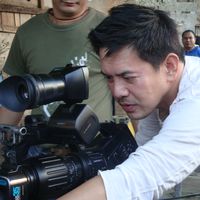Lav Diaz And The Insane Struggle For Evolution
This past September Lav Diaz's new film Ebolusyon ng Isang Pamilyang Pilipino screened as part of the Visions section of the Toronto International Film Festival. 10 long, arduous years in the making, it was the World Premiere of the 10-hour version of the film, something Lav has fondly labeled as the "Toronto-cut" (he intends to re-edit the film, adding a few scenes and shooting additional footage, expecting the final running time of the film to last about 11 hours). Ebolusyon… follows the life of a rural family from the years 1971-1987 and examines the impact society --Ferdinand Marcos' Martial Law era, and the post Martial-Law Cory Aquino presidency -- has on their lives.An 8 hour very rough version of the film (dropped frames, no sound in some scenes, ungraded) was shown as part of the Asian Cinevisions Festival in New York earlier in 2004, thanks largely to the stubborn insistence of one Roger Garcia.
From 11:00pm to 4:45am of the morning Lav was supposed to leave for Toronto I was helping as best as I could the process of dubbing out the film to mini dv and transferring it to DigiBeta by acting as driver and shuttling the mini dv tapes from his editing studio in Cubao to the transfer house in San Lorenzo Village Makati. While sitting in his editing studio (i.e. tiny room barely big enough to house the computer and monitors he was editing on) waiting for one tape to dub out, we slipped in an impromptu interview. The questions were scattered and random, and the interview only about 1/3 complete before I had to rush out to deliver another tape while Lav had to tweak the sound on another hour of the film.
To make matters worse, as I was transcribing the interview, roughly 30 percent into what was already an abbreviated exchange; the sound dropped out and became garble. I fast forwarded the tape, but the rest of it was the same. 70% of the interview was lost. My disappointment only eclipsed by the knowledge of the myriad problems the post-production has been mired in.
What follows is the interview that took place. Two tired souls reflecting on the tail end of one chapter in the post-production of what I do not doubt will be one of the most important Filipino films of the last decade.
At your own frustration feel free to read that transpired…
-------------------
Alexis Tioseco: It's 2:30am on the day after Lav Diaz was supposed to leave for Toronto, and we're dubbing out the last three hours of the film. He'll be leaving in four hours for Toronto. (Lav laughs)
You've been working on this film for 10 years. You started in film the 1994.
Lav Diaz: 1994. March 8. The camera rolled on March 8, but we actually started in 1993, December, with the Pre-Production
Alexis Tioseco: What was the story like then?
Lav Diaz: It revolves around a Filipino seaman that jumped ship in New York. The Philippine scenes were just a flashback, but at this point the New York, New Jersey, and all the Maryland shoots are gone. [The Philippines scenes] have evolved from a flashback into a big story. This is the story now. What we shot in America is a different film now.
Alexis Tioseco: Do you intend to do something with that footage?
Lav Diaz: I will. Of course, yeah. They're very cool. They're all in 16mm. Beautiful. I just want to see the footage and maybe we can do something with that. It's going to be organic again. There's another story there, it's a beautiful story.
Alexis Tioseco: How did this evolve into the story that it is now? What was it in the Philippine story that made you want to continue it?
Lav Diaz: The main reason for the evolution is that we don't money. We shoot only if we have money. The ratio will be like twice a year, every time we have money. So I always adjusted the story to the condition; to the situation. One key factor was the kid in the film, Ryan. We got him from Smokey Mountain; he was just eight years old then. So every year we shoot, we adjust; he's growing. Now he's like 17, 19.
Alexis Tioseco: Ryan is his name or the name of his character?
Lav Diaz: Ryan is his name. The name of the character is Reynaldo, Reynaldo Gallardo. The kid is Ryan De Vera, from Smokey Mountain. He still lives there.
Alexis Tioseco: He still lives there?
Lav Diaz: Yeah. With his family. We're trying to help him get out of that place, after this film, with his family actually. He's a good actor.
Alexis Tioseco: This is both your first and your latest film.
Lav Diaz: Yes
Alexis Tioseco: How has your perspective of cinema, how has the way you see your work, and what you are trying to do with it, changed since you started and are now finishing this work?
Lav Diaz: It changed a lot. When I was starting I was still groping and looking for my aesthetic. Through the years, while I've been searching, it's evolved. Now, I'm very clear with my aesthetic now. If you compare that to a growing person, in 1994 I was child, in relation to cinema, my aestheticism. But now I've matured, I've found it; I know what I'm doing. My vision is clear. I know what I'm doing now; I know what the purpose of my art is. It's very clear now.
Alexis Tioseco: Do you think that will affect this work in the effect that some parts will be from the person who was searching for his vision, and some parts will be made by the director that has understood what he's looking for?
Lav Diaz: Yeah, it's like that. The very idea of Ebolusyon is like that; the search, the study; the examination. Just like Batang West Side. It's still an extension of that perspective; that search for answers. It's the same with my cinema. It evolved and it involved, and I know what I'm doing.
Alexis Tioseco: This film was funded entirely independently.
Lav Diaz: Yeah, my and my friends money.
Alexis Tioseco: It was produced by you and Paul Taneda.
Lav Diaz: Yeah, Paul Taneda.
Alexis Tioseco: In terms of physical money that was put out, how much did the film cost?
Lav Diaz: For 10 years, the total would be… [takes a moment to calculate mentally], around 1.2, 1.4 Million (pesos).
Alexis Tioseco: That's including the 16mm shoots, and the digital shoots?
Lav Diaz: Yeah. Very cheap, man. Very cheap.
Alexis Tioseco: But that's subtracting the shoots that are not included in the film, the New York shoots, the New Jersey shoots…?
Lav Diaz: That's part of it.
Alexis Tioseco: That's including it?!
Lav Diaz: My mathematics is poor, but it's around that, at most 2 Million maybe.
Alexis Tioseco: Or 40 thousand dollars for a 10 hour film.
Lav Diaz: 2 Million is 40 thousand dollars?
Alexis Tioseco: Yeah, just about it.
Lav Diaz: Yeah, 30 thousand plus dollars.
Alexis Tioseco: So all of the crew and cast, with the exception of Angie (Ferro)…
Lav Diaz: …they're not paid yet. It's a deferred pay situation. We'll try to find money when we show this film, all over. We'll try to find money for them. Definitely we're going to pay them, a minimal amount… a little.
Alexis Tioseco: But they understand that with a work such as this, a work of this length, it will be difficult to sell and make money from public screenings?
Lav Diaz: They don't even expect payment anymore. What we said was we would be able to save a little, or sell this film in some parts, then they're going to get their due. We're going to pay them.
Alexis Tioseco: How difficult was it to get actors and crew to work under such circumstances?
Lav Diaz: It was difficult during the early years. But now, as my name became known, it became easier. People who believe in art, they just volunteered to work. Actors also, they wanted to work with me. Mowelfund people especially. We treated the film as a workshop. Anybody could come in at any time during the shoot. It's a workshop; it's a very collective working. You can see a lot of people working. In one department you can see 20 people working, 10 people. Sometimes there's nothing, nobody's working, because everybody is working outside. It's a workshop; it's a collective work. No rules; just shoot, with that vision to finish the film. Some, they wanted to help me; they really helped me; because they believed in what they were doing. For a lot of them, it was like that.
Alexis Tioseco: When the film started, it started with a story written by someone else that you tried to adapt.
Lav Diaz: I had an original story, but I figured that my friend's story, Eric Camarines, was better-- the idea of a young Filipino that jumped ship and then befriended the ghost of a veteran. The ghost of the veteran eats red roses to be able to survive. Then, when I was doing the preproduction...
[tape gets messed up and incomprehensible]
...
Similar content
By Kerrine Goh
30 Apr 2004
By Kerrine Goh
12 Feb 2012
By Kerrine Goh
30 Sep 2009
By Kerrine Goh
30 Nov 2011




